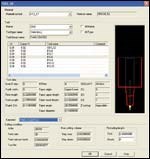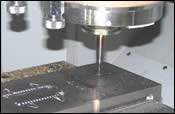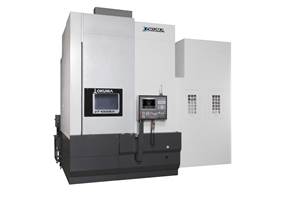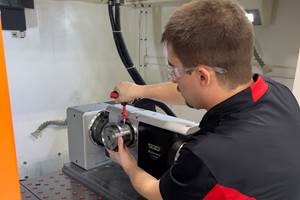The Hard Milling Imperative
Hard milling allows mold components to be machined in the hardened state, thus skipping several expensive and time-consuming processes such as electrical discharge machining and hand polishing.
Corey Greenwald “gets it.” He understands that hard milling is becoming an essential capability for shops producing plastic injection molds. He understands how to perform hard milling operations effectively, routinely and confidently in his own shop, Hard Milling Solutions. He understands that as mold shops turn to hard milling, they are likely to need such a specialty shop to handle the hard milling they can’t handle, either because they do not have enough time on their own machines or because they aren’t quite ready to perform hard milling on their own.

Corey Greenwald (above right) and Kevin Hunter inspect the details of a mold block produced on one of the shop’s Makino V56 vertical machining centers. This block (right) is made of hardened H13 tool steel. A 1.0-mm diameter ballnose end mill with a 12:1 length to diameter ratio was the smallest tool used in this project, which substantially reduced EDM and polishing operations for the customer.
Unfortunately, when it comes to hard milling, many mold shops don’t “get it” yet. They are stuck doing mold machining in traditional ways. As a result, they end up spending time hand polishing molds and then spending more time struggling to “spot” the molds in final trials and tests.
“All these extra hours represent the difference between competitive and non-competitive moldmaking in a global market,” Mr. Greenwald says. “Unless these shops change their machining methods, they are going to have a hard time surviving,” he concludes.
Mr. Greenwald strongly believes that hard milling is one of the most important answers to this problem, especially in smaller molds and inserts. He says that hard milling can help a mold shop start with hardened steel and produce finished mold surfaces that require little or no hand polishing. That allows them to skip several time-consuming, labor-intensive steps in the moldmaking process. Hard milling capability, he adds, is also a boost to machining shutoff surfaces on one side of the mold to a “negative stock” condition. This leaves a slight gap between mating mold surfaces, thus greatly reducing the time and effort to do the final alignment and adjustments (spotting) of the mold when it is first in the press. The mold will last longer and run faster, too.

A complete and accurate model of the cutting tool in its holder allows the programming software to check for possible collisions or gouging of the workpiece with 100 percent accuracy, thus allowing predictable, unattended cutting.
“By applying hard milling properly, a mold shop should be able to take mold components off the machine tool, assemble them, put them in the injection machine and get a good part with the first shot.” Mr. Greenwald says. “With hard milling, a mold shop can take time and cost out of both the machining and the spotting of plastic injection molds.”
So what’s to get about hard milling? According to Mr. Greenwald, hard milling requires a whole new kind of thinking about how to machine metal. Hard milling takes a certain kind of machine tool, a certain kind of cutting tool and toolholder, and a certain kind of programming software. All of these pieces of technology have to be in place, and all of them have to work together perfectly.
“Once you get everything going and understand how it fits together, hard milling is a reliable, predictable and productive process,” Mr. Greenwald says. As proof, he points to the fact that his shop’s two vertical machining centers (designed especially for the demands of hard milling) often run virtually around the clock with minimal attention.
A Shop Is Born
How Mr. Greenwald became a highly respected practitioner and strong proponent of hard milling is an unusual story. He started out as a manufacturing engineer, eventually getting involved in shop management at a die/mold shop in the suburban Detroit area. One of the projects he oversaw was the installation of a machining center to hard mill forming punches for hot-forged powdered metal connecting rods.
The results were impressive. Production of the punches dropped from 30 days to 6. This was better than what the shop owners expected, and it was as far as they wanted to go. Mr. Greenwald, however, saw even more potential to save time and cut costs with hard milling.

The entire surface of this mold cavity was milled in the hardened state to a 12-rms finish and required no further benching and zero spotting time. The mating core was also hard milled. Shutoff surfaces on the cavity side were machined to a negative stock of 0.0008 inch. This mold produced a good part in the first shot.
Around the same time, Craig Sizemore, one of Mr. Greenwald’s friends in the Detroit die/mold community, was also taking an interest in hard milling. His shop, Cut-Rite EDM, Inc., specializes in advanced wire electrical discharge machining (EDM), and he was exploring hard milling as a complement or alternative to EDM. Mr. Sizemore believed that a counterpart to his EDM shop was needed to service shops looking for hard-milling capacity and experience.
With Mr. Sizemore’s support, Mr. Greenwald opened Hard Milling Solutions in Shelby Township, Michigan, about 30 miles north of downtown Detroit. That was in August 2004. Hard Milling Solutions operates in leased space next door to Mr. Sizemore’s shop. Unlike Mr. Sizemore, though, Mr. Greenwald was not trained as a machinist or tool and die maker. His only experience working closely with machining was related to the hard-milling application at his former employer.
This encouraged, rather than deterred, Mr. Greenwald. He knew enough about hard milling to realize that it had to be approached with the same rigorous discipline and vigorous curiosity that sustained him as a manufacturing engineer. That still left him with the practical aspects of learning how to perform hard milling and of equipping a shop to do it effectively. For that, Mr. Greenwald turned to Single Source Technologies, an Auburn Hills, Michigan, distributor of machining centers and EDM equipment from Makino (Mason, Ohio) and other builders. Single Source had been active in promoting high speed machining and hard milling in the metro Detroit area and had helped Mr. Greenwald set up the hard-milling machine with his former employer.
He attended the workshops and training courses about high-performance machining at Single Source, and he credits this training as the basis for his success in hard milling. When Hard Milling Solutions went into operation, it was with a Makino V56 machining center and one employee to help run this machine.
Although Mr. Greenwald got his start with the help of these outside forces, he quickly realized that hard milling still required a lot of pioneering on his part. Because the shop was set up to specialize in hard milling, he began encountering a variety of hardened steel grades that ranged into the 60s of the Rockwell hardness C-scale. The machining data tables from Single Source gave him a starting point, but much of the work required experimentation and test cuts.

When high speed machining techniques are applied to mold components in the hardened state, a mold shop can take some of the most expensive and time-consuming steps out of the mold machining process.
Today, about half of the shop’s work is in plastic injection molds, most of this using hardened H13 and S7 tool steels. The shop also specializes in medical machining, including joint replacement forging dies as well as die details, die-cast core cavity inserts, powder metal tooling end forms and anything as hard as 65 Rc. The original machine has been joined by a second V56. Mr. Greenwald continues to keep both machines in operation with one other employee, Kevin Hunter, a mold maker with 30 years of experience.
Because hard milling is all his shop does, Mr. Greenwald says he could hardly help becoming a rather advanced expert at it. Even so, for selfish and unselfish reasons, he wants to see hard milling more widely adopted by mold makers in the United States. He believes that, as more shops invest in this technology, they will be more likely to turn to his shop with overflow work or particularly difficult jobs. More importantly, he believes that hard milling represents the future of moldmaking in this country. “Right now, there’s no better way to make moldmaking profitable in the face of surging mold imports from low-wage countries,” he says.
Hard Milling in a Nutshell
Hard milling is an offshoot of high-speed machining techniques. The essence of high-speed machining is taking many light cuts at closely spaced stepovers, thus leaving minimal cusps between passes. The goal is to create an as-machined surface that drastically reduces the need for subsequent processing. For the cutting tool to achieve an effective chip load, feed rates and spindle speeds must be much higher than those normally applied in traditional machining; hence the name high speed machining. The high feed rates also make it possible to complete a much larger number of passes across the workpiece more quickly than with traditional methods.
Hard milling takes the concept of high speed machining one step further. The combination of light cuts at high feed rates and spindle speeds makes it possible to remove steel in the hardened state efficiently when all of the proper conditions are met. Likewise, closely spaced stepovers with small-diameter, radiused tools leave a surface that approaches the fineness of one that has been stoned or polished by hand. (Mr. Greenwald reports routinely achieving surfaces of 10-12 rms with hard milling when needed.) Because the steel is already hardened, subsequent heat treating, stress relieving or grinding steps are unnecessary. More importantly, the process also replaces many costly steps with EDM.
The ability to hold extremely tight tolerances (±0.0004 inch or less) is an added benefit of hard milling that is valuable in mold machining. It allows mold contours to be machined without the excess stock normally left for hand spotting. Moreover, by machining to zero stock, mold geometry will perfectly match that of the CAD model. Likewise, this ability allows mating mold surfaces to be machined to a negative stock condition. The concept is to machine shutoff areas along the parting lines, usually on the cavity side, slightly but precisely below the nominal dimension. This leaves a small gap between the surfaces that would normally contact each other when the mold closes. Gap size is too small (0.0008 inch is typical) to allow plastic to flow out during the injection process, so the mold still shuts off effectively. The gap allows air within the mold to escape readily, without additional provisions for venting, as molten plastic is forced inside. Small contact pads in corners maintain the gap—otherwise, shutoff surfaces do not touch each other. The interference between these surfaces that must normally be resolved during spotting and fitting is eliminated. In addition, the gap eliminates the impact between these surfaces when the core and cavity sides come together so that the sharp edge at the parting line is fully protected.
From the Tip Up
Like any CNC machining process, hard milling depends on a capable machine tool, the appropriate cutting tool/toolholder system and an effective toolpath program. Unlike other machining processes, however, the interaction of these elements is somewhat more complex and dynamic, although certainly not beyond the reach of new users approaching it with determination, commitment and openness to change, Mr. Greenwald says.
“Getting a grip on hard milling can be a challenge, but there is one way to get your mind around it,” he points out. The way to understand hard milling, he says, is to understand that it is all about protecting the tip of the cutting tool. “It all boils down to what makes the tip cut safely and effectively. If you understand that, then you can work backwards and understand the system requirements and their interactions. You manage all of those interactions so that the tip of the end mill cuts coolly and freely, with consistent engagement in the material. Everything else falls into place.” That said, he adds that if any part of the system is neglected or breaks down, then the tip of the cutter suffers and the whole process starts to fail.
Working up from the end mill, Mr. Greenwald outlines the critical factors in each element.
The Cutting Tool
Hard Milling Solutions typically uses ballnose end mills for roughing, semi-finishing and finishing. Two-flute ballnose end mills are used exclusively for finishing, and these finishing cutters are the most critical elements in the hard-milling process. For finishing, the end mill must meet two essential requirements: it must have a near-perfect radius and have virtually unblemished cutting edges. Accuracy of the radius has to be extremely tight so that a high or low flute does not cause uneven metal removal, thus degrading geometry, surface quality and tool life. The end mills used in the shop for finishing are certified to a radius accuracy of at least ±5 micron (±0.0004 inch). On occasion, the shop has used end mills 0.012 inch in diameter with a radius certified to ±0.0002 inch.
The cutting edges of the flutes must have a minimum of microscopic chips, cracks or other irregularities. The presence of these defects means that the edges will be subject to accelerated wear mechanisms as soon as they contact the workpiece. This leads to a rougher surface finish and a shortened tool life. Tool life is an issue because the shop depends on its end mills to last as expected when running its machines unattended.
Cutting tools that meet these specs are now readily available from suppliers such as OSG (Glendale Heights, Illinois) and NS Tool (distributed in North America by Single Source Technologies), but they are considerably more expensive than standard items. Because tools of this quality are absolutely necessary, however, cost is not an issue. “They are the foundation that makes it possible to skip polishing and spotting down the road, so they are an essential investment in the hard-milling process,” Mr. Greenwald says.
The Toolholder
The toolholder has to protect the radius and edge quality of the end mill. Mr. Greenwald believes that shrink-fit toolholders with HSK interfaces provide the most protection. Shrink-fit clamping provides the lowest runout of any current clamping method, thus minimizing the slight off-center rotation of the cutting tool. Runout causes the tool to cut excessively with one flute, thus increasing the chip load on that flute and shortening cutter life.
Hard Milling Solutions uses a Haimer shrink-fit system. According to Mr. Greenwald, it takes less than a minute to exchange and reclamp cutting tools and return them to the automatic toolchanger. In his experience, shrink-fit clamping routinely holds runout to less than 0.0001 inch.
The shop buys only balanced HSK toolholders and avoids any abusive handling. The HSK interface is mandatory because it provides stiffer, more accurate and more secure clamping in the spindle than other tapered styles.
The Spindle
Just as the toolholder protects the end mill’s sharp edges and accurate radius, the spindle in turn has to protect the integrity of the cutting tool/toolholder assembly. Of course, the spindle also has to be designed for the high rpm that hard milling requires. Controlling heat and vibration in the spindle is very important. Direct-drive spindles (no gears or belts for power transmission) and internal cooling are usually dictated by hard-milling applications.
The pair of V56 vertical machining centers installed at Hard Milling Solutions has spindles with these features. Both spindles are rated at 20,000 rpm.
Machine Construction
Discussing the spindles on these machines can’t be separated from a discussion of the overall machine construction of which they are a part. “It almost goes without saying that machines for hard milling have to be extremely rigid,” says Mr. Greenwald. Volumetric accuracy is also important.
The machines in his shop are designed especially for the thermal stability and rigidity demanded by his applications. Some of the construction features that distinguish these machines from general-purpose models include:
- Heavy base and column (these models weigh more than 20,000 pounds)
- Core-cooled spindle
- Box ways with linear roller bearings
- Dual supported ballscrews
“From my perspective, what is important is minimizing the vibration and tolerance stack-ups that might reach the cutting tool. Whether I’m cutting with a 0.5-mm end mill at 40 ipm or a 6-mm end mill at 380 ipm and holding accuracy in the tenths, the effects of system variables are magnified. Everything has to be controlled,” Mr. Greenwald says.
The CNC processors and servo systems on these machines are also designed for hard milling. Pertinent features include:
- Dual RISC processors, one of which is dedicated to the data transformations necessary to turn programmed tool paths into servo commands.
- Look-ahead capability of 120 blocks to avoid over- or undershoots in tool travel.
- Effective interpolation of high-resolution encoder feedback for precise position control.
- Glass scales for feedback in 50 nanometer increments.
Programming Software
However, the performance of a rigid yet responsive machine tool depends on the NC programming input. This leads to what Mr. Greenwald considers one of the least understood aspects of hard milling—the influence of the tool paths driving the CNC.
“It all goes back to the tip of the cutting tool, where we started,” he explains.
The perfect radius and edges of the cutting tool rely on a “smooth ride” to cut safely and accurately when machining hardened materials. This is why most CAM software is inadequate for hard milling. The algorithms that generate tool paths are not designed for the smooth, accurate moves to the tolerances required for the kind of hard milling that allows mold shops to bypass entire steps of the moldmaking process.
As Mr. Greenwald sees it, typical CAM software is designed to produce tool paths quickly, so most systems use processing shortcuts that generate code efficiently. This software is great for general milling applications, because the effects of these shortcuts don’t matter. The output is more than accurate enough for this kind of work. The problem is, this virtue becomes a vice in the realm of hard milling, he says.
His shop uses CAM-TOOL as its programming software. This software, developed in Japan, is sold in the United States by CGS North America, Inc., which is located in Windsor, Ontario, and led by Randy Nash, its new president. Chris Renaud, one of the company’s sales and applications specialists, has worked with Hard Milling Solutions and understands its applications. “Corey’s shop typifies the needs of hard milling, especially for mold work,” he says.
According to Mr. Renaud, this software does not create a triangulated mesh approximating the surface of contoured geometry because these approximations stymie the accuracy needed for hard milling, which is measured in millionths of an inch. Instead, the software calculates the tool path based on points taken directly from the geometry. In fact, he says, the points are connected by mathematically defined curves that best fit the points, as opposed to using straight line segments that connect the center points of each triangle in a mesh laid over the contours. Because the resulting path is a series of curves, the motion defined in the tool path lacks abrupt changes in direction that short line segments create. A machine tool with nanometer feedback resolution will attempt to move along those segments without compromise, creating a jerky, stuttering effect that puts cutting tools at risk.
Effective tool paths for hard milling have other requirements, according to Mr. Renaud. They must:
- Control how the cutting tool enters and exits the cut;
- Maintain a constant chip load by controlling the engagement of cutting edges with workpiece material; and
- Provide constant stock conditions for each subsequent roughing or finishing pass.
Algorithms for accurately analyzing the as-machined shape of the workpiece geometry are the key to meeting these goals, Mr. Renaud says. Tool paths for hard milling must not create the conditions that work against the ability of the cutting tool to generate the accuracy and surface finish that can take a mold right to the press.
Add It All Up
When the chain linking the tip of the cutting tool to the programming software has no weak links, hard milling becomes predictable and reliable. This is why unattended operation is feasible. It’s a practice that Hard Milling Solutions does, literally, day in and day out. “For each machine, we average about 100 or more hours a week of minimally attended operation,” Mr. Greenwald says. About 90 percent of all jobs are run totally unattended. “If you have to stand in front of the machine on these jobs, then they weren’t programmed correctly,” he says. The only time he or Mr. Hunter watches a job closely is when one of the men is experimenting with smaller cutters or harder materials than previously encountered and he needs to learn all he can about system performance.
He stresses, however, that routinely operating in the unattended mode is not an option or a bonus with hard milling. He says that running almost around the clock is the only way to make the machines pay for themselves and provide a healthy return on the investment. Unattended operation represents more than high machine output with low labor input. It also represents numerous hours of benching and spotting at high labor costs that have been taken out of the process.
The benefits to the mold-buying customer are so compelling that hard milling should be irresistible to the mold builder. By eliminating or drastically reducing electrode milling, EDM, grinding, polishing and spotting on the press, hard milling takes out some of the most expensive and time-consuming steps in the mold-building process. For this reason, Mr. Greenwald considers hard milling to be a make-or-break technology for U.S. mold shops.
Their survival ensures his because he knows that there will be plenty of extra hard milling work or unusually difficult jobs that will come his way.
Related Content
Vertical Lathe Executes Heavy-Duty, Long and Continuous Cutting
New VT1000EX Vertical Lathe from Okuma America Corp. possesses the capability to cut and machine difficult materials through, according to Okuma, its highly rigid, mechanical configuration, extreme thrust and torque.
Read MoreThree-Axis Bridge Mill Opens New Doors for Construction OEM
Different industries often require different machining priorities, a truism recently demonstrated by Barbco, an OEM of heavy-duty boring equipment that opened up new design possibilities by pivoting toward rigid, less complex machining centers.
Read MoreWhat to Do When Five-Axis Machining Is Off the Table
For Fischer USA, 3+2 machining with a high-precision rotary table adds flexibility without the cost of a full five-axis machine.
Read MoreAdditive/Subtractive Hybrid CNC Machine Tools Continue to Make Gains (Includes Video)
The hybrid machine tool is an idea that continues to advance. Two important developments of recent years expand the possibilities for this platform.
Read MoreRead Next
3 Mistakes That Cause CNC Programs to Fail
Despite enhancements to manufacturing technology, there are still issues today that can cause programs to fail. These failures can cause lost time, scrapped parts, damaged machines and even injured operators.
Read MoreThe Cut Scene: The Finer Details of Large-Format Machining
Small details and features can have an outsized impact on large parts, such as Barbco’s collapsible utility drill head.
Read More
















.png;maxWidth=300;quality=90)





.png;maxWidth=300;quality=90)







